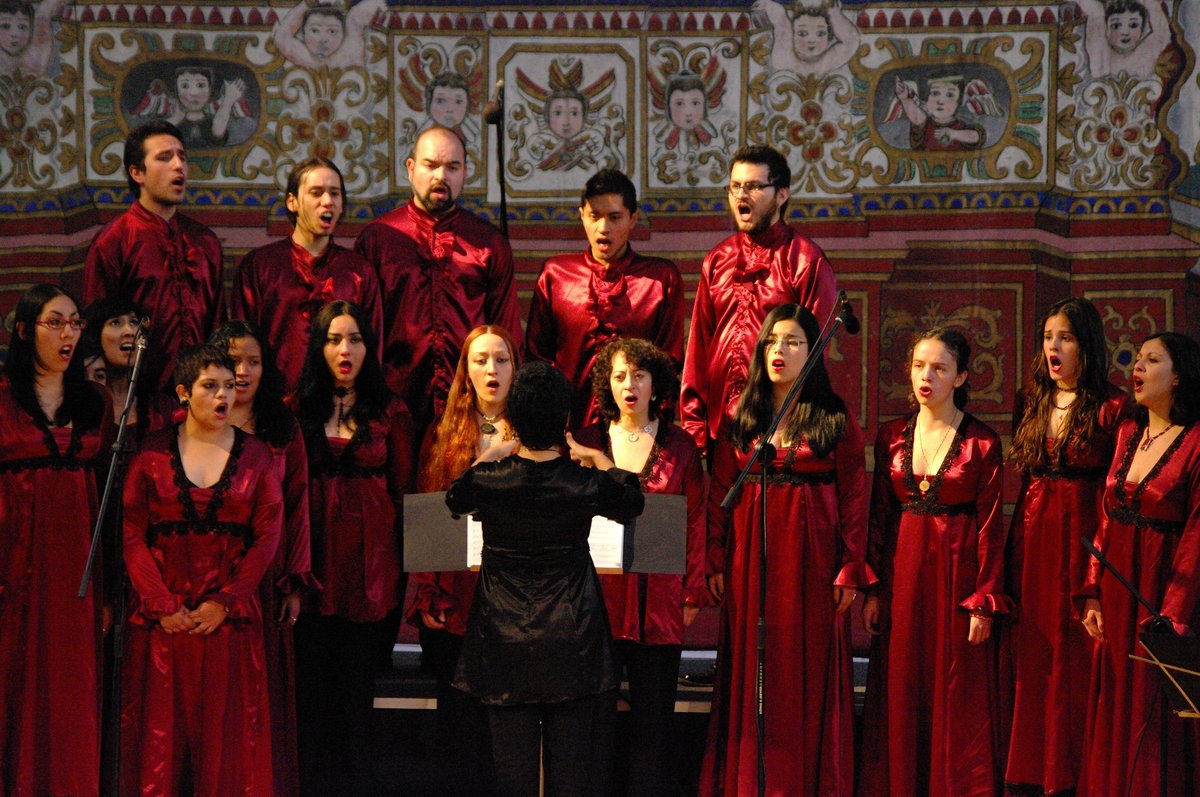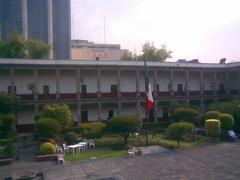
Universidad del Claustro de Sor Juana: Visiting Hours, Tickets, and Historical Significance in Mexico City
Date: 14/06/2025
Introduction
Located in the heart of Mexico City’s Centro Histórico, the Universidad del Claustro de Sor Juana (UCSJ) stands as a remarkable testament to the city’s colonial heritage, intellectual tradition, and vibrant cultural life. Originally the Convent of San Jerónimo, this historic site honors Sor Juana Inés de la Cruz—Mexico’s preeminent poet, philosopher, and early feminist—whose life and work continue to shape UCSJ’s mission. Today, the university is both an academic and cultural landmark, offering guided tours, exhibitions, festivals, and a window into centuries of Mexican history (MexConnect, Academia Lab, El Claustro).
Table of Contents
- Historical Overview
- Visitor Information
- Key Attractions and Campus Highlights
- Special Events and Cultural Activities
- Nearby Attractions
- Practical Tips for Visitors
- Frequently Asked Questions (FAQ)
- Conclusion and Recommendations
- References
Historical Overview
Origins as the Convent of San Jerónimo
Founded in 1585 as the Convent of San Jerónimo, the site was established by Isabel de Barrios and became a prominent spiritual and intellectual center. Built in the austere Herreriano style, the convent provided a semi-autonomous life for nuns, reflected in its spacious patios and private cells (MexConnect).
Sor Juana Inés de la Cruz and Her Legacy
Sor Juana resided here from 1669 until her death in 1695. The convent allowed her scholarly pursuits, resulting in a prolific body of work that challenged societal norms and elevated Mexican literature and philosophy (Academia Lab). UCSJ continues to honor her with research centers, exhibitions, and annual cultural events.
19th and 20th Century Transformations
After Mexico’s independence, secular reforms led to the closure of the convent. The building was repurposed for various uses, suffering architectural damage over time—including a period as a cabaret in the mid-20th century (MexConnect). By the 1970s, the site faced deterioration until expropriation and restoration were initiated.
Restoration and Archaeological Discoveries
Extensive archaeological work from 1976 to 1982 revealed colonial-era tiles, fountains, drainage systems, and tombs, preserving the site’s historical fabric while adapting it for educational and cultural functions (Academia Lab).
Founding of Universidad del Claustro de Sor Juana
The restored complex became UCSJ in 1979, emphasizing humanities, literature, philosophy, gastronomy, and the arts. The university maintains its dual role as a center for academic inquiry and a vibrant cultural venue (AllUniversity.info).
Visitor Information
Location and Access
- Address: José María Izazaga 92, Centro Histórico, C.P. 06080, Mexico City (El Claustro)
- Main Entrance: On Izazaga Street, easily accessible via Metro (Isabel la Católica, Salto del Agua, or Pino Suárez stations) and multiple bus routes.
Visiting Hours
- Museum and Cultural Spaces: Monday to Friday, 10:00–17:00; Saturday, 10:00–13:45 (Programa Destinos México)
- University Activities: Monday to Friday, 9:00–19:00
- Special Events: Check the official website for updates.
Admission and Ticketing
- General Admission: Usually free for museum and exhibitions; some events/workshops may require tickets or registration (rugcmx.org).
- Special Events: Fees may apply for select workshops or seasonal festivals.
- Discounts: Students, seniors, and children may receive reduced rates for paid events.
Guided Tours
- Languages: Tours in Spanish are offered regularly; English tours are available by request. Group tours should be booked at least one week in advance.
- Focus: History, architecture, Sor Juana’s life, art exhibitions, and archaeological discoveries.
Accessibility
- The university has made adaptations for accessibility, but due to the colonial architecture, some areas may present challenges (uneven floors, stairs, narrow passages). Contact UCSJ in advance for accommodations (elclaustro.mx).
- Accessible restrooms and ramps are available in select areas.
Photography Policy
- Non-flash photography is generally allowed; flash and tripods may be restricted to protect artifacts and during performances.
Best Time to Visit
- Weekdays and mornings offer a quieter experience.
- Major cultural events, especially the Day of the Dead altar (late October–early November), are highlights but attract larger crowds.
Key Attractions and Campus Highlights
- Patio del Gran Claustro: Main cloister featuring baroque and colonial architecture—often the venue for cultural events.
- Auditorio Divino Narciso: Former convent church, now a concert and performance hall.
- Celda Contemporánea: Gallery for contemporary art exhibits, often juxtaposed with colonial remains.
- Site Museum (Museo de Sitio): Showcases colonial artifacts, convent life, and Sor Juana’s legacy (Mexico City Government).
- Restaurante Escuela Zéfiro: Student-run restaurant serving contemporary Mexican cuisine in a historic setting (wikicity.com).
Special Events and Cultural Activities
UCSJ’s cultural calendar features over 250 events annually, including:
- Day of the Dead Altar (Ofrenda): Monumental altar honoring Sor Juana and Mexican traditions.
- Encuentro de Poesía Iberoamericana Elsa Cross: Iberoamerican poetry festival.
- Feria del Libro: Annual book fair.
- Coro Virreinal “Rita Guerrero”: Baroque and colonial music concerts.
- Art Exhibitions: Rotating shows in Celda Contemporánea and Foro R-38.
- Workshops and Lectures: Covering literature, philosophy, gastronomy, and the arts.
For detailed event schedules, consult the UCSJ website or social media channels.
Nearby Attractions
UCSJ is ideally situated for exploring other Mexico City landmarks:
- Palacio de Bellas Artes
- Alameda Central Park
- Museo de la Charrería
- Casa de la Acequia
- Regina Coeli Church & Convent
- Templo Mayor and Zócalo
These sites are within walking distance or a short metro ride away, making UCSJ an excellent starting point for cultural excursions.
Practical Tips for Visitors
- Language: Most signage and tours are in Spanish; some English materials and guides are available.
- Dress Code: Modest attire is recommended, especially in historic or religious spaces.
- Weather: Mexico City’s climate is mild; bring an umbrella during the rainy season (June–September).
- Security: The area is generally safe during the day; university security is present.
- Dining: Reservations are recommended for Zéfiro, especially during events.
Frequently Asked Questions (FAQ)
Q: What are the visiting hours?
A: Monday to Friday, 10:00–17:00; Saturday, 10:00–13:45. University activities run Monday to Friday, 9:00–19:00. Always confirm on the official website.
Q: Are tickets required?
A: Admission is generally free; special events may require registration or a nominal fee.
Q: Are guided tours available in English?
A: Yes, but they should be booked in advance.
Q: Is the site accessible for visitors with mobility issues?
A: Some areas are accessible, but historic architecture may limit access. Contact UCSJ for details.
Q: Is photography allowed?
A: Non-flash photography is usually permitted; restrictions may apply for certain exhibitions.
Q: How can I get to UCSJ by public transport?
A: Metro stations Isabel la Católica, Salto del Agua, and Pino Suárez are within walking distance.
Conclusion and Recommendations
Visiting the Universidad del Claustro de Sor Juana is an immersive experience in Mexico City’s colonial, literary, and cultural history. Whether you are drawn by the legacy of Sor Juana, the allure of baroque architecture, or the dynamic program of concerts and exhibitions, UCSJ is a must-see destination. Make the most of your visit by joining a guided tour, attending a cultural event, and exploring the nearby attractions of Centro Histórico.
Stay up to date on exhibitions, hours, and special programming by visiting the official UCSJ website and following their social channels. For enhanced experiences and exclusive content, download the Audiala app.











































































































































































